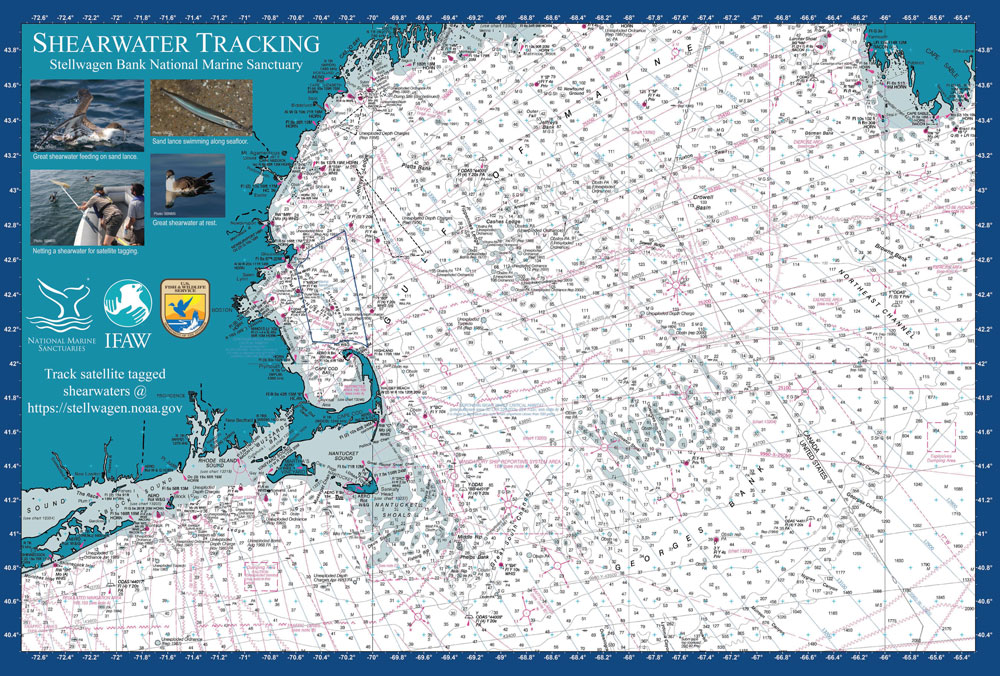
Sanctuary scientists want to learn more about how seabirds react to changes in their primary food source and what factors cause changes in forage fish abundance. Signals from the tags have allowed scientists to plot bird movements. They can then relate the movements to oceanographic features such as water temperature, bathymetry, chlorophyll concentration, ocean fronts and other factors that might result in increased productivity or that concentrate prey. This year, two tagging missions will attempt to tag sets of mature and immature birds to study differences in feeding patterns and migration routes.
On July 13 and 14, 10 great shearwaters were tagged for the annual project. An earlier mission in June found that the captured birds were all below the required weight as necessitated to carry a tag. Great shearwaters come to the Stellwagen Bank National Marine Sanctuary and other areas in the Northwest Atlantic to feed and bulk up for the long migration to their breeding grounds in the South Atlantic in our winter (their austral summer). June was just too early. An additional five tags acquired for the project will be applied to birds captured in September.
Summary reports of the birds' travels and cumulative maps of each bird's tracks will be updated monthly. The maps are to be used for educational purposes only. For more timely notices, check our Twitter (@NOAASBNMS) and Facebook and the project's associated twitter account @TrackSeabirds.
It appears that the tracking season has ended as of New Year's Day 2022. The last holdout was Shuri, whose tag stopped transmitting after 171 days and 42,591 km. This bird's movements were unlike any other in the course of the 10 years of this research project; it's track will be discussed later on in this report. Researchers lost contact with Bessie, the other shearwater to reach the South Atlantic this year on December 16. Bessie was likely a juvenile (no apparent interest in the breeding colonies) and was moving south on the Patagonian Shelf off of Argentina. Some of our other birds may have reached the South Atlantic, however, their tags failed too early to know.
Our seabird expert Kevin Powers believes Shuri may be very close to breeding age, but is not there yet (a sub-adult). He notes that the bird may be thinking about breeding in a more serious way this year as it spent some time on Inaccessible Island (an island in the Tristan da Cunha archipelago that is protected as a wildlife reserve), including possible time in a burrow (the signals stopped for a short time). Shuri made several forays off Inaccessible Island westward (most likely to feed in an area about a third of the way to Argentina). When the bird's tag finally failed, it was moving west and south.
The birds will be making their return migration soon, usually a more direct flight north to feeding grounds in the North Atlantic. Researchers hope that the 2022 crop of tagged shearwaters includes several adults to provide additional data about the timing and location of migratory paths.
Background: The Tristan da Cunha archipelago includes the main, inhabited (population approximately 250) island of Tristan, and the uninhabited wildlife reserve islands of Inaccessible and Gough (although there are a few South African weather station personnel stationed there), and the small uninhabited Nightingale Islands. On our tracking maps, the red dots indicate Inaccessible Island (upper left) and Gough Island (lower right). This archipelago is considered the world's most remote island community. It is reported that the only way to get there is by boat, and that a trip from South Africa takes six days. In 2020, the community committed to designating almost 700,000 square km of its waters as a Marine Protected Area.
By the end of November only eight tags continued to transmit location data. A late October nor'easter affected the birds on Georges Bank, shifting them southwestward to various degrees. The tags for Jemison, Volgenau8, and Britney Shears survived the storm and all three birds returned to mid-to-north Georges Bank (still feeding). We lost signals from Jemison and Volgenau8 (Nov 13 and Nov 16, respectively). On Nov 23, Britney Shears traveled about 700 km east into the North Atlantic (along Latitude 40N) before its tag failed on November 29. Bessie, the great shearwater that visited the new high seas marine protected area in the mid-Atlantic – NACES (North Atlantic Current and Evlanov Sea basin), started its migration on November 25, heading almost directly south along Longitude -30W, crossing the Equator on December 1. Shuri, our long-distance leader at 33,000+ km at the end of the month, had reached Inaccessible Island in the Tristan da Cunha archipelago (Latitude 37S, Longitude -12W). The bird's signal went quiet for a few days (probably blocked while in a burrow), then reappeared and started moving westward to -25W. The bird turned around and went back to Inaccessible Island, where the signal was again lost (Nov 30). [Note: the signal reappeared on Dec 2 as the bird flew west again.] Seabird experts are perplexed by the bird's movements and believe these might be foraging trips. They're hoping that next year genetic tests will provide information about bird gender to better analyze behavior.
Not much seemed to happen during most of October, and then a nor'easter hit New England and the Gulf of Maine. Five great shearwaters (Birdy McBirdface, Britney Shears, Jemison, Tuskegee, and Volgenau8) that were actively foraging around the Gulf of Maine and Georges Bank during October were pushed south or southwest by the storm, with Volgenau8 recording the greatest one-day movement of some 400 km on October 26th. The storm, with its extreme pressure gradients, may likely be the reason why two more tags are no longer transmitting – hopefully it was due to equipment failure and not the loss of Birdy McBirdface and Tuskegee. Bessie has been hanging out all month in the middle of the Atlantic between North America and Europe. For part of the month, the bird visited the newest high seas marine protected area – NACES or North Atlantic Current and Evlanov Sea basin MPA (recognized as an important foraging area for northeast Atlantic seabirds and long-distance migratory species). At the beginning of the month, Shuri reached South America's Patagonian Shelf. This bird worked its way down to an area seaward of the bay of the River Plate/Rio de la Plata (southeast of Buenos Aires, Argentina and Montevideo, Uruguay). This bird is most likely a non-breeder, as it has made no move to visit the breeding colonies on the remote Tristan da Cunha Islands (midway between South America and South Africa in the South Atlantic), site of another new marine protected area. At the close of the month, the final distance-traveled tally shows Shuri as the leader at 24,626 km, and we're now down to five transmitting birds.
September (and summer) have come to a close and our birds are racking up the miles (kilometers). Shuri, named after a fictional comic book scientist, has a total of 19,363 km as of October 3 and is now located on the Patagonian Shelf off Argentina. Our bird experts believe this shearwater may not be a breeder, as those birds head to the Tristan da Cunha islands (the most isolated place in the world) between southern South America and South Africa. Bessie remains at high latitudes in the North Atlantic and seems to be hanging out over the Mid-Atlantic Ridge; the experts think the behavior looks more like methodical foraging than migration. Birdy McBirdface and Britney Shears have been actively patrolling Georges Bank, while Volgenau8 is there now after making some forays off the bank (and adding to its total distance, which now stands 2nd at 13,610 km). Tuskegee has been spending considerable time in the Platts Basin area in the northwestern part of the Gulf of Maine while Jemison was taken to the northern part of the gulf and Jordan Basin. The tags for Arliner, Ashanti, and E.E. Just went silent on 8/18, 7/22, and 8/21, respectively.
By the end of August, seven tags were still signaling and the birds were traveling – some of them over quite impressive distances. Five birds finished the month in the Gulf of Maine, either on Georges Bank (Tuskegee, Birdy McBirdface, Shuri) or in the Great South Channel between Georges Bank and Nantucket Shoals (Volgenau8 and Jemison). One bird (Bessie, named after the first Black/Native American woman to obtain a pilot's license) has made a fairly straight flight NE to the Grand Banks and at the end of the month was just west of the Flemish Cap. This may be a breeding bird beginning the long-distance migration that will eventually take it down to the southern South Atlantic. The last bird has the most unusual track – the bird seems to be stretching its wings and trying something a bit different. Britney Shears was located south of Long Island near Hudson Canyon and then continued to move southward off the continental shelf.
Total distances traveled for all birds (as of 8/29/21, including those birds whose signals are no longer
received):
Arliner (stopped 8/18/21): 3,907 km
Ashanti (stopped 7/22/21): 503 km
E.E. Just (stopped 8/21/21): 1,108 km
Bessie: 5,953 km
Birdy McBirdface: 5,233 km
Britney Shears: 4,444 km
Jemison: 4,232 km
Shuri: 5,156 km
Tuskegee: 6,390 km
Volgenau8: 7,730 km
Of the ten satellite tags, one seems to have failed (Ashanti) but the other nine continue to send signals. All tracks started just east of Chatham, Massachusetts where the science team captured, sampled, tagged, and then released the birds.
The seabirds appear to be using two distinct feeding areas. One group – Arliner, E.E.Just, Jemison, and Shuri are staying around the outer Cape Cod slope including northward to Stellwagen Bank or southward to Nantucket Shoals and Great South Channel areas. The second group – Bessie, Ashanti, Volgenau8, Tuskegee, and Britney Shears have targeted Georges Bank. Volgenau has logged the most distance as of July 26 (1,702 km). Before its tag stopped transmitting, Ashanti appeared to be moving along the tidal front on northern Georges Bank. Birdy McBirdface is in both groups and seems to be quite the traveler (1,273km).
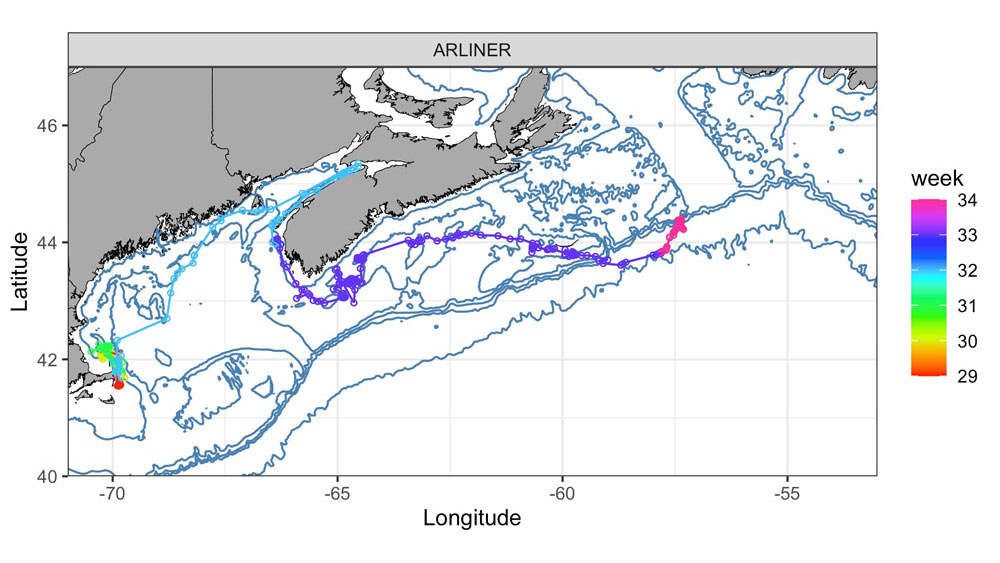
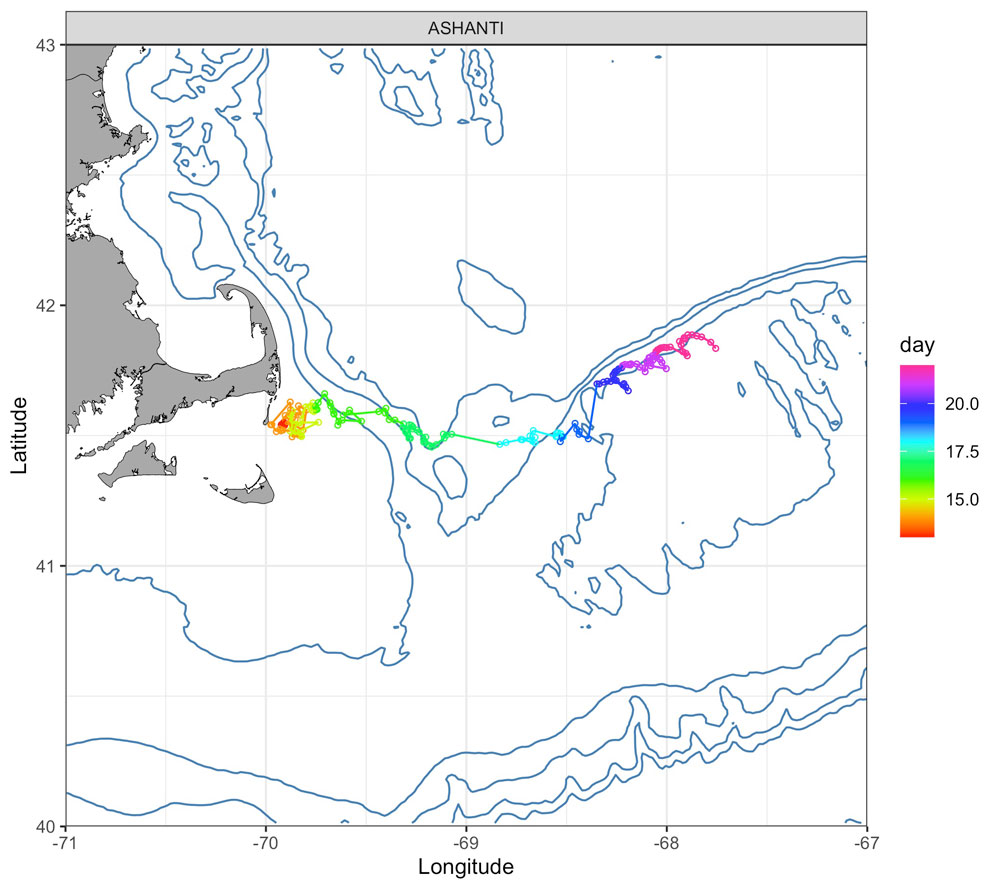

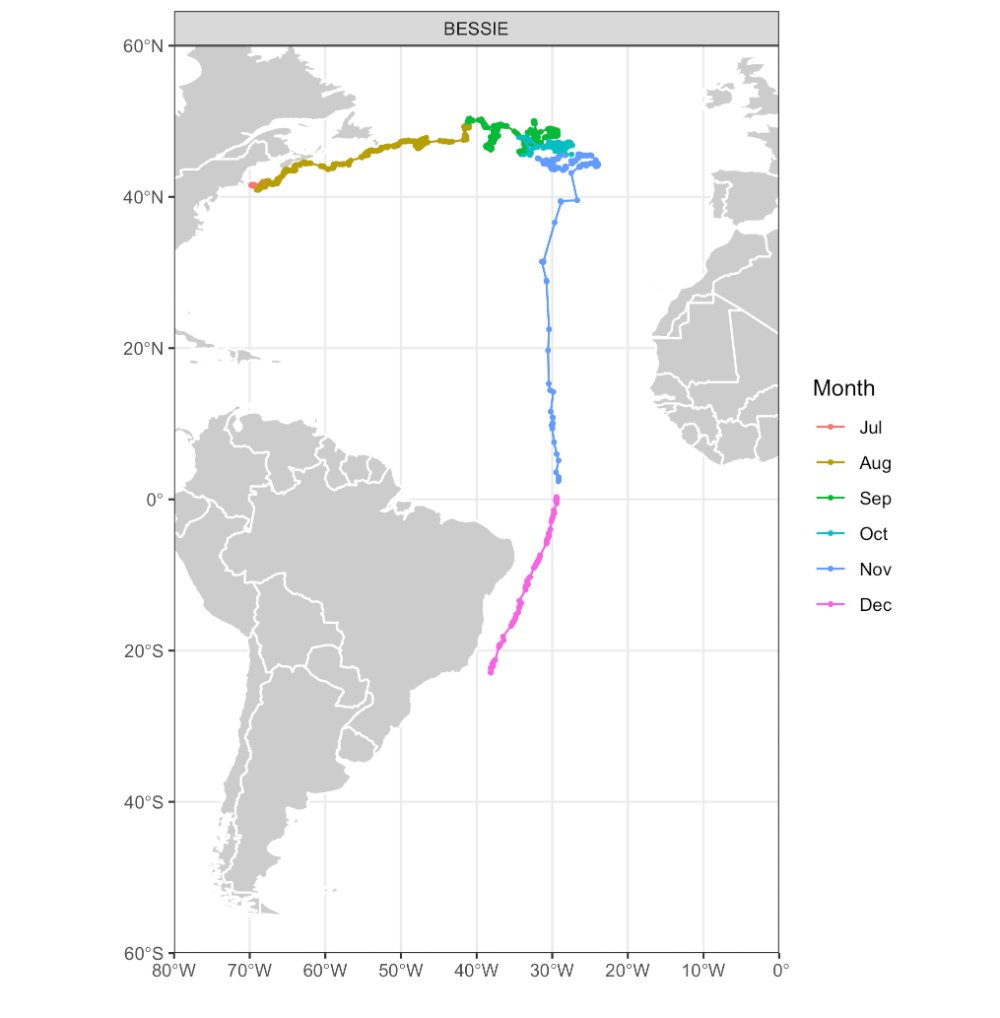
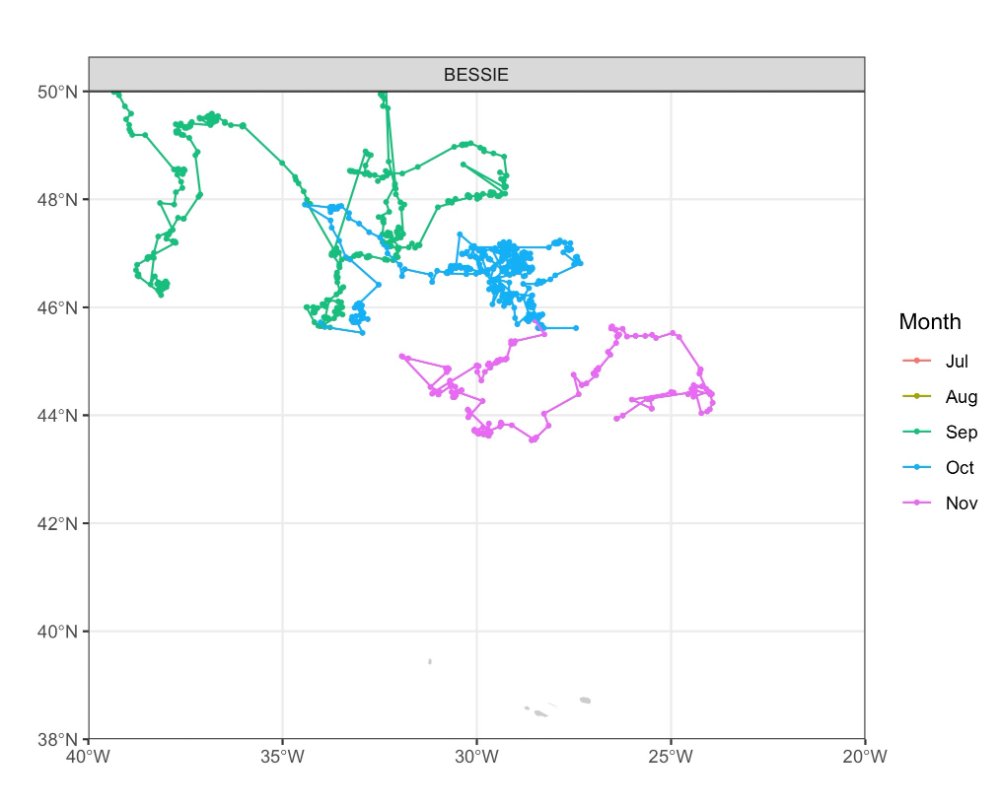
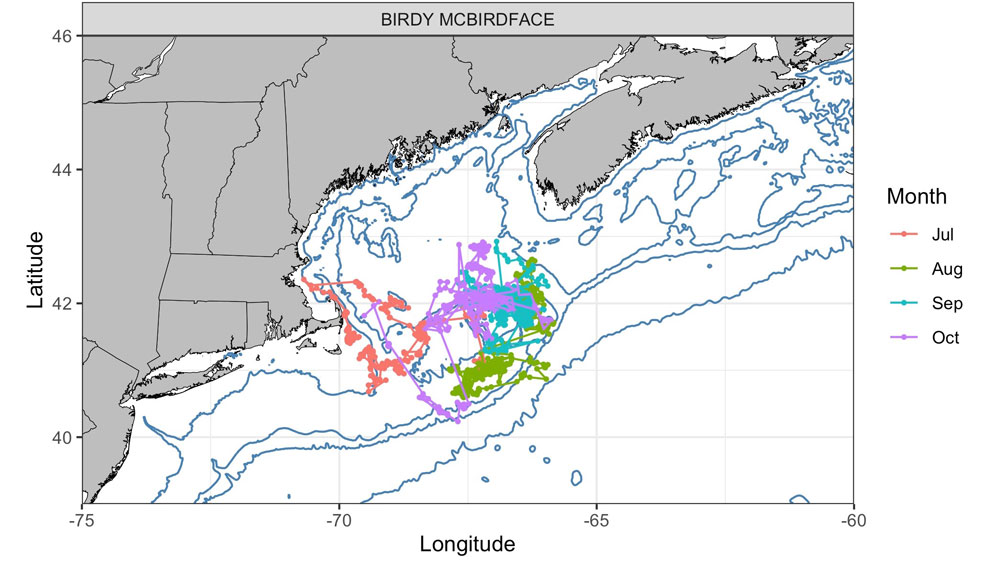
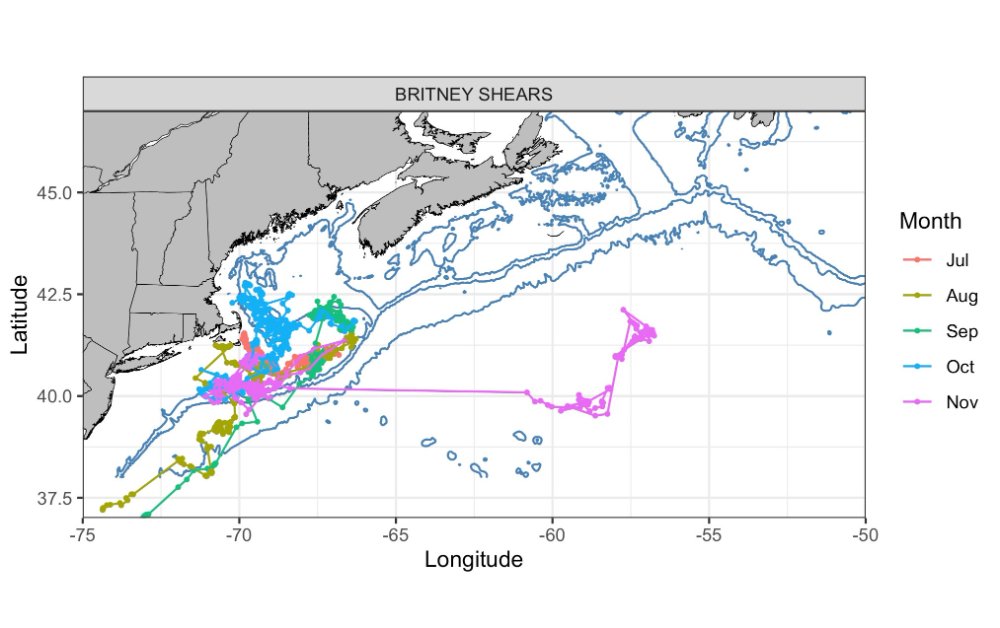
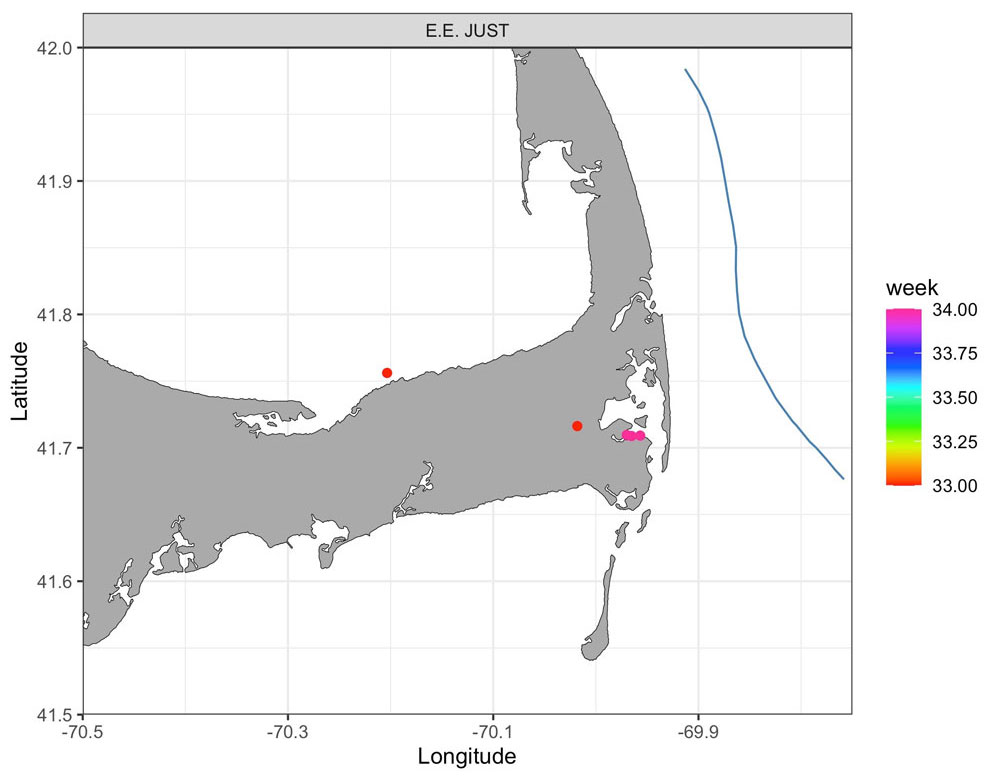
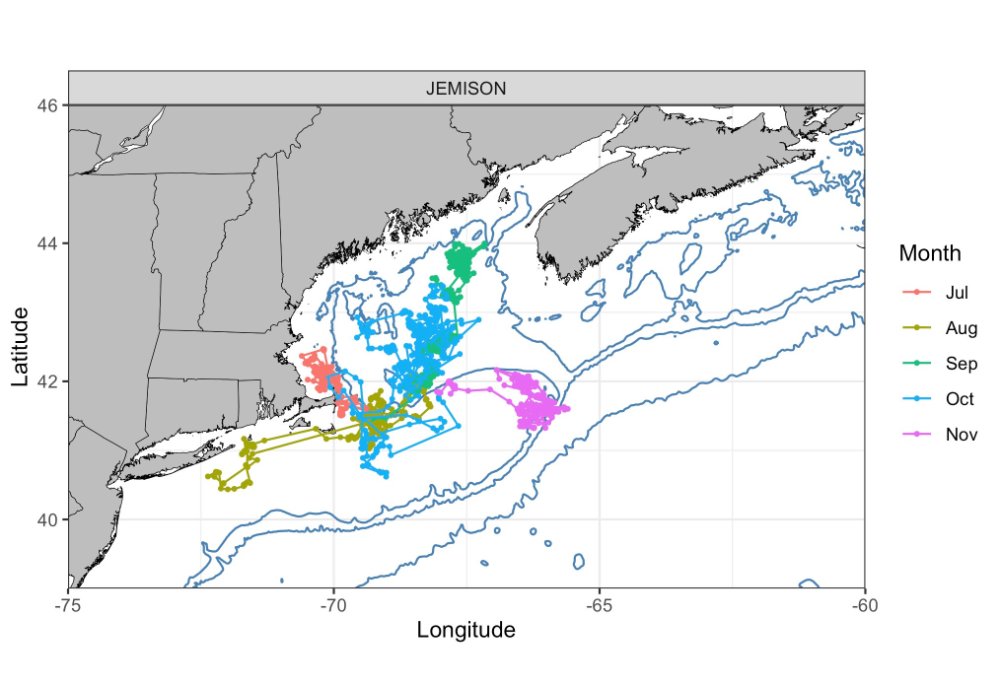
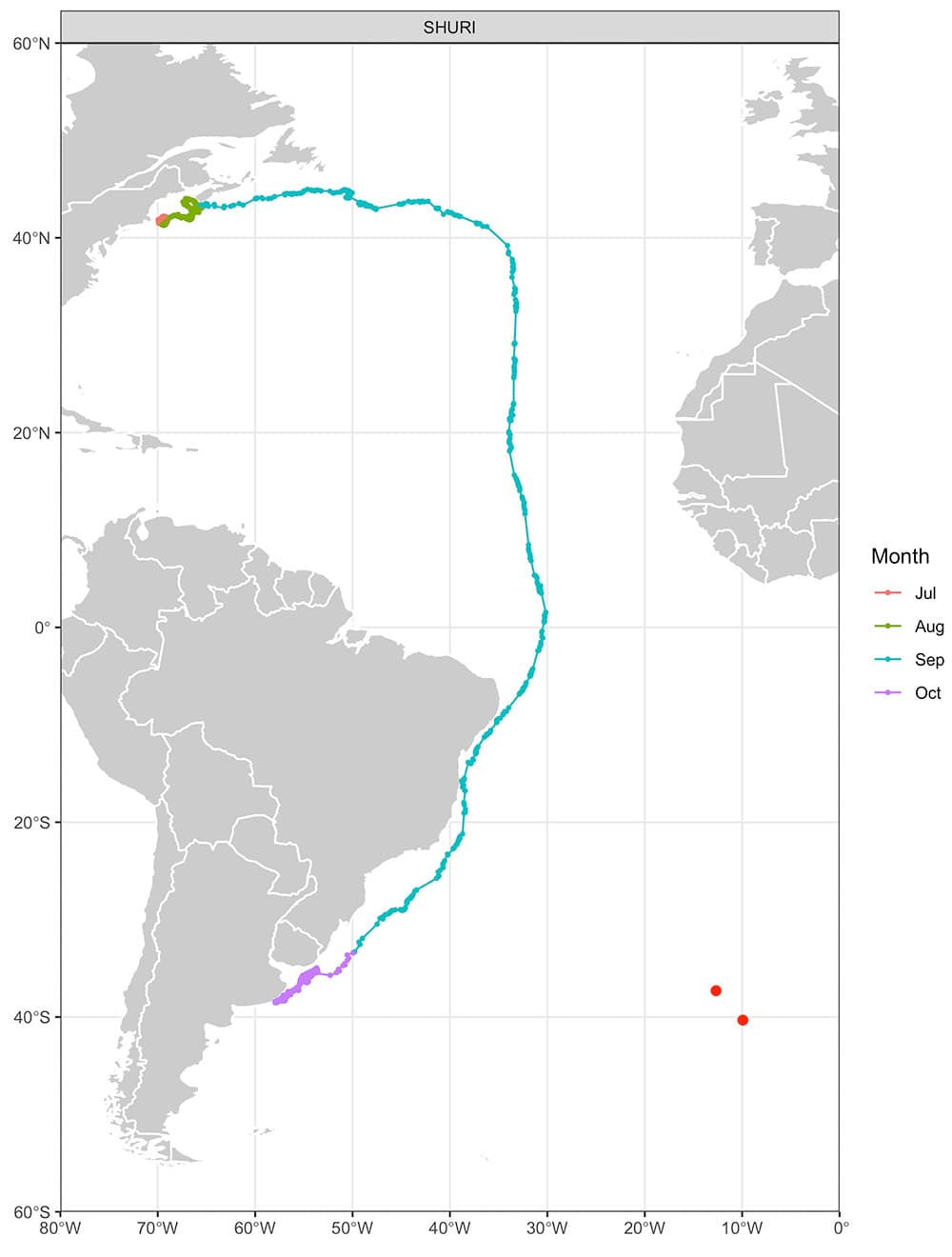
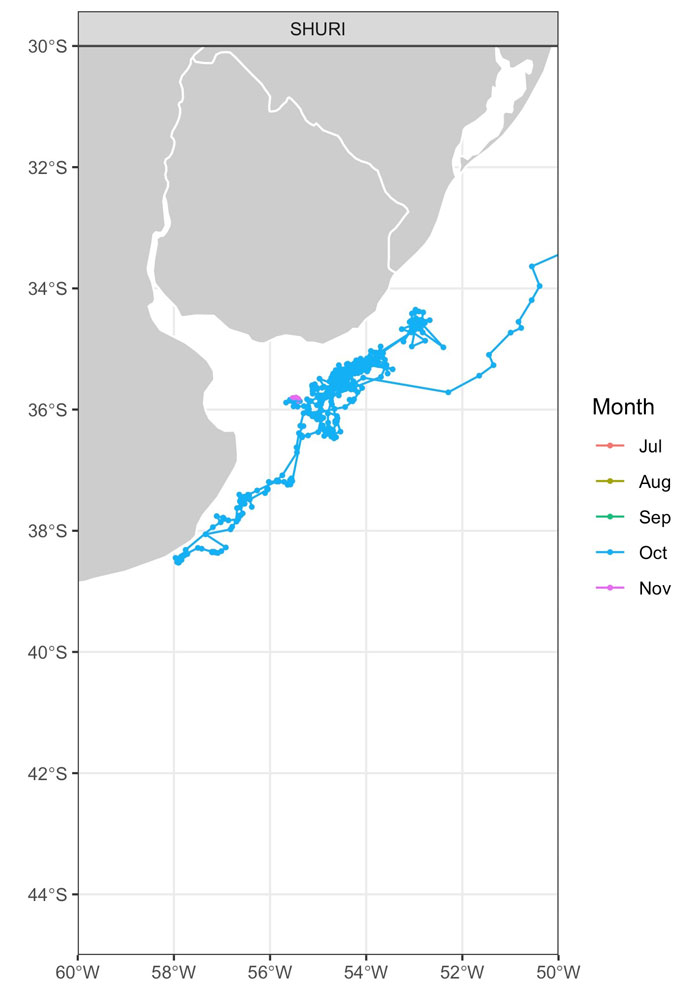

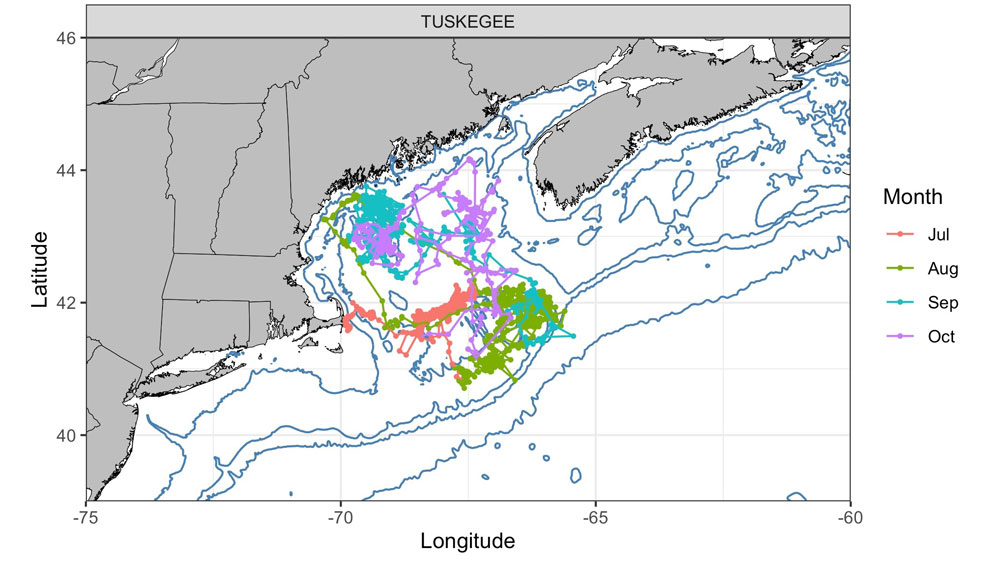
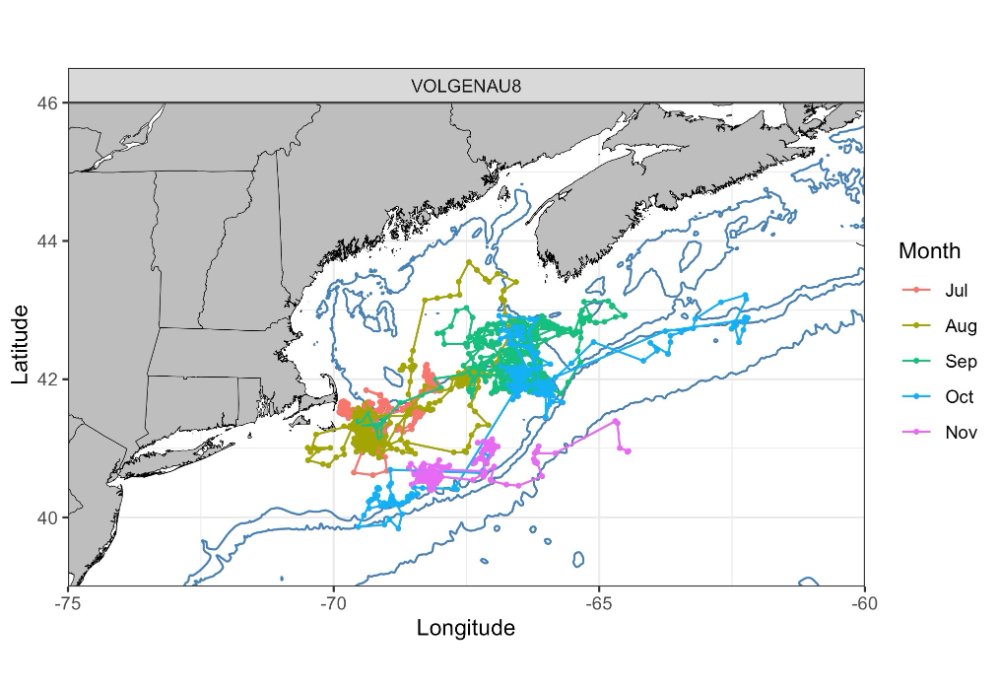
For Educators: The sanctuary offers two maps for tracking shearwater movements. One map is for the Gulf of Maine and the second is of the Atlantic Ocean (North and South Basins). The coated surface on the paper allows for the placement and removal of sticky dots for repeated use. The sanctuary education team has prepared a generic tracking activity and other background materials. Email stellwagen@noaa.gov for more information.
The Team: Dr. David Wiley, research ecologist for the sanctuary, leads the shearwater tagging project. Additional sanctuary staff include Michael Thompson, sanctuary geographer and GIS specialist, and Dr. Tammy Silva, postdoctoral researcher, along with Kevin Powers, a volunteer with the Stellwagen Sanctuary Seabird Stewards program and seabird expert. The research team includes Linda Welch, U.S. Fish and Wildlife Service seabird specialists at the Maine Coastal Islands National Wildlife Refuge, Dr. Les Kaufman, Boston University, Dr. Kent Hatch, Long Island University, Dr. Anna Robuck, University of Rhode Island, and Dr. Robert Ronconi Environment and Climate Change Canada. Funds for the project have been provided by the Volgenau Foundation, Bureau of Ocean Energy Management, the Davis Foundation, and the Mudge Foundation.